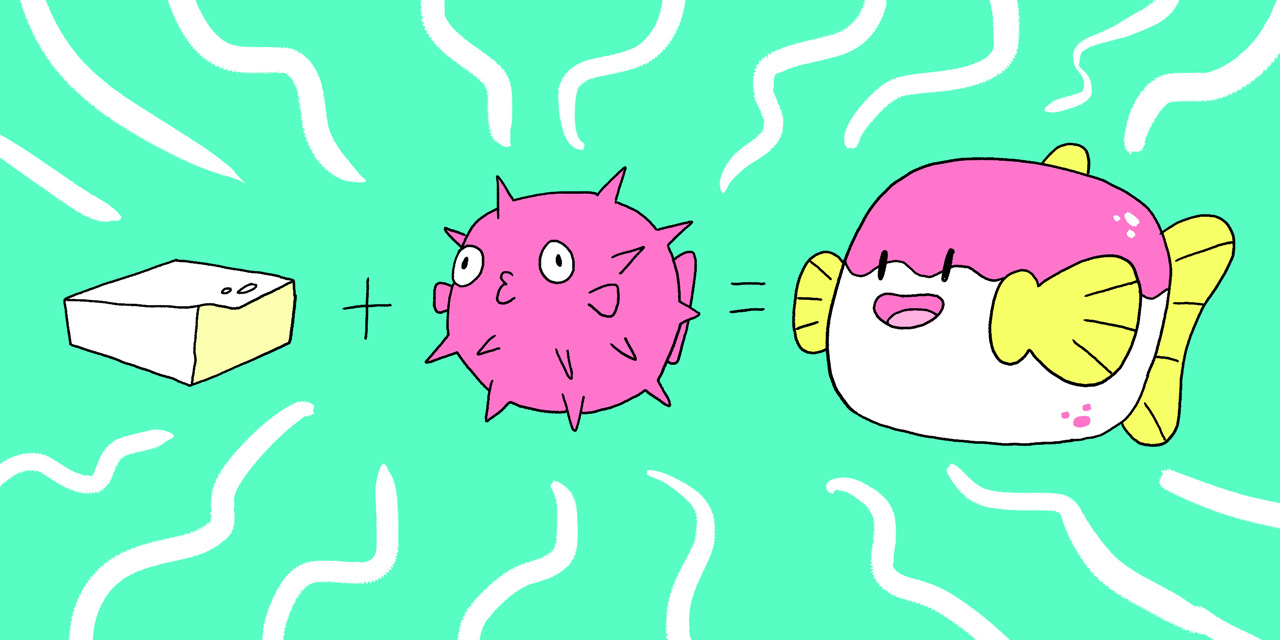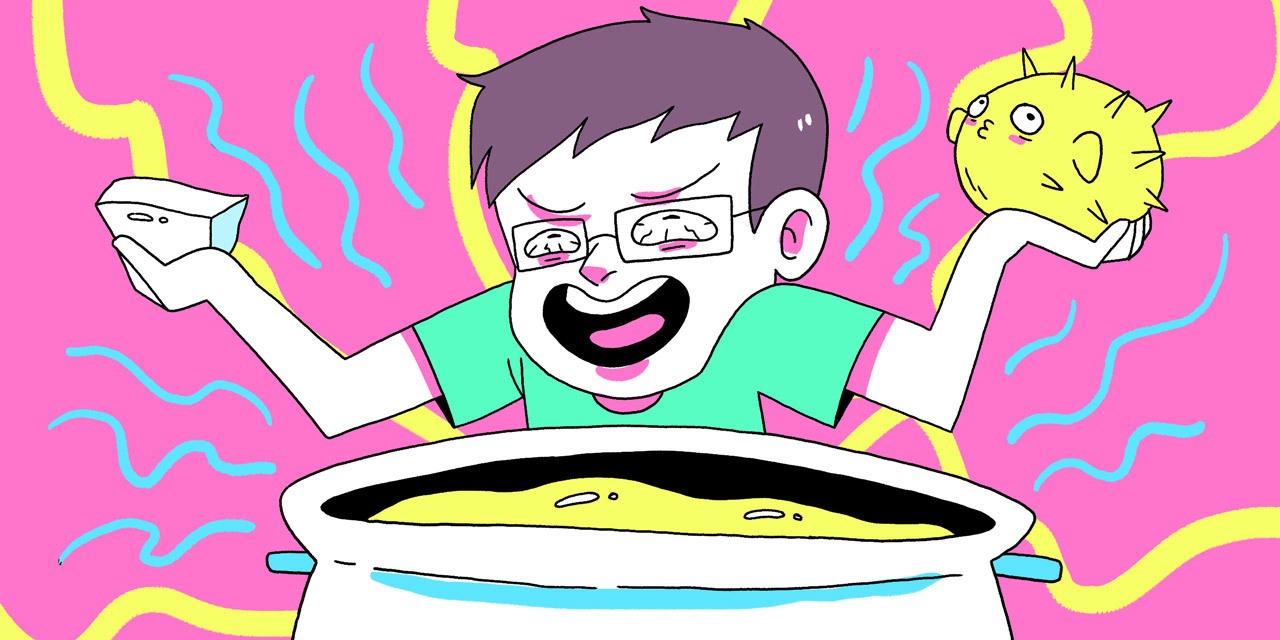Even if you are a beginner of Japanese, you probably recognize the Japanese particles こと and から. But it's usually not until the intermediate or advanced levels that you learn ことから (kotokara), which looks like those two beginner particles Voltron'd together.
No matter what your Japanese level, you will understand, and be able to use, the particle ことから after reading this guide. In order to do that, I'm going to start you off with a small step back so you can take an even bigger leap forward.
Lesson Prerequisites:
- The ability to read hiragana and katakana.
- A beginner level of Japanese grammar.
- An open heart.
Not Required but Helpful:
- An understanding of the particles こと and から.
- Some kanji literacy.
Ready to get started? Let's unravel this mystery together.
Particles こと and から

If you have a pulse, you probably noticed ことから looks like a combination of the two particles こと and から. The question is, will the meanings of these individual particles help us learn ことから?
The answer is "yes."
First, let's quickly review how these particles work on their own:
こと:
The particle こと is a catch-all noun that represents a "thing," or an "action." In terms of the particle ことから, the important thing to know is that when you add こと to a phrase, it nominalizes it. That means it turns that phrase into something that can be treated like a noun. Some examples:
- 食べる: To eat.
- 食べること: The action of eating.
-
食べることが 好き: I like the action of eating.
- 書く: To write.
- 書くこと: The action of writing.
- 書くことが好き: I like the action of writing.
から:
から is a grammatical particle that shows an origin, or a source – that is, the point from which something comes.
It can be used with:
| Japanese | English | |
|---|---|---|
| Space | 私の 家から | From my house |
| Time | 昨日から | Since yesterday |
| Cause and effect relationships | 嵐から | Because of/From the storm |
You probably noticed ことから looks like a combination of the two particles, こと and から. But will the meanings of these individual particles help us learn ことから?
Thankfully, both of these particles give us a clue as to what the meaning of ことから might be. I'd like to encourage you to see if you can guess it, based on the information above.
Go ahead and try. I'll wait.
Waiting…
Waiting…
If you tried to guess ことから's meaning, you might have come up with something like: "from (から) a thing (こと)" or "because of (から) a thing/action (こと)." Either of these would be pretty close to the definition of ことから, actually. This means you're only one or two steps away from understanding it.
The Meaning of ことから

Right now, our meaning for ことから is at "from/because of a thing/action." With that in mind, here are some of the more common English translations for ことから:
- "From the fact that ~"
- "Based on ~"
- "Due to ~"
- "Given ~"
- "Owing to ~"
We weren't that far off! And, now by looking at the English translations, we're given a couple more important points:
- ことから is a fairly formal expression. The English translations ooze formality, right? You wouldn't say "From the fact that you're perusing Twilight novels, I gather you're interested in vampires." It's formal speech, not casual.
- The idea of cause and effect is emphasized in these translations, at least compared to how you would translate から on its own (it's usually translated as "from" or "because of"). Although "from" and "because of" have very similar meanings to the above list of translations, phrases like "due to," "owing to," and "from the fact that," really make you think one thing caused another thing. Remember this, we'll be coming back to it very soon!
- There is an emphasis on truth. When you say "Due to the destruction of the earthquake," you're implying what you're talking about is real or common knowledge. This is another thing to remember because it will come up later.
With this list of definitions, as well as these three points in mind, it's time for you to learn exactly what the Japanese particle ことから is. Here's a simple definition for you:
ことから links two separate ideas into one cause and effect relationship. The first idea is always a fact-like piece of information, or something that is well-known to a lot of people. The second idea is a reaction to that piece of information.
If you didn't quite understand, that's okay. We're going to break it down to the smallest parts possible, then work our way up to full-on sentences. Let's pull a couple of things from the above ことから definition.
- We are working with two "ideas." These can be two phrases, two statements, two whatever. We'll call them
AandB. - The first idea
Ashould be a fact-like piece of information, or something well-known to a lot of people. Basically, it should be something that is accepted as being true. - ことから lives between the two ideas,
AandB. This creates a cause and effect relationship between them.Bhappens because of, or as a result ofA.
Using those three points, here is the simplest possible ことから pattern.
AことからB
We said the second idea B is in reaction to A. And, A is the basis of B (i.e. B is happening because of / due to / owing to A).
There is a cause A, and an effect B. Using our earlier English translations for ことから as examples, we could say things like:
Due to
A,B/Bis due toADue to the storm (A), the power went out (B)
The storm (A) ことから the power went out (B)
Owing to
A,BOwing to poor sales (A), Radio Shack went bankrupt (B)
Poor sales (A) ことから Radio Shack went bankrupt (B)
Bis based onAGodzilla attacked the nuclear facility (B) based on his unquenchable hunger (A)
Godzilla's unquenchable hunger (A) ことから Godzilla attacked the nuclear facility (B)
Bis from the fact thatAFrom the fact that you are wearing a Crabigator t-shirt (A), I can surmise that you are a fan of WaniKani (B).
You are wearing a Crabigator t-shirt (A) ことから I can surmise that you are a fan of WaniKani.
Given that
A,BGiven that you are a world champion arm wrestler (A), I probably cannot defeat you (B).
You are a world champion arm wrestler (A) ことから I probably cannot defeat you (B).
In these examples, could you use the particle から instead? Sure! So why even use ことから when から can mean basically the same thing? It comes down to a couple of things, and I think looking at the こと portion of ことから will help us to differentiate ことから from から.
Think about こと. What does it tell us? Well, the big thing is it tells us we're dealing with some kind of thing or action. That thing or action is "the action of A," so essentially we're saying "the action of A causes B," not just "A causes B" (which would be the から-only version).
Consider the difference between those two phrases, for a moment. What is your impression when you read each?
To me, saying "The action of A causes B" sounds a little more reliable. It sounds more like a fact. You're bundling up whatever it is you're saying in A in a こと wrapper. It feels more set in stone with the こと on there.
And, that right there is an important aspect of ことから. The A portion of "AことからB" needs to be some kind of reliable piece of information. Something that's fact-like, or well-known.
ことから suggests that the phrase preceding it is some kind of reliable information. Something that actually happened, or is known to be true.
から, on its own, is more broad. The A in "AからB" could be reliable information (which is a requirement for the A in "AことからB") but it doesn't have to be.
For example, I could say "monkeys love playing mahjong から zoos always give them mahjong pieces to play with," but I couldn't say "monkeys love playing mahjong ことから zoos always give them mahjong pieces to play with."
Why? Because it's not generally accepted, or even factual, information. から doesn't have this requirement, but ことから does.

We've spent a lot of time looking at the A portion of the "AことからB" pattern, so now let's turn our attention to B.
B in ことから is always going to be a direct reaction to A. B happens because of A. This can be an actual action taken in response to A, or a conclusion based on A. "Monkeys with knives are dangerous ことから the zoo decided not to give them knives."

The B portion (the zoo decided not to give them knives) is an action that took place as a result to the generally accepted information in A (monkeys with knives are dangerous).
Finally, the ことから itself creates a logical connection between A and B. Not only will the conclusion of B make sense to the speaker/writer, but it is also assumed it will make sense to the listener/reader as well. It is, after all, a logical connection. It should make sense.
Using ことから in a Sentence

With all of that information in mind, let's take a look at some sentences. You'll find each example contains all of the following:
Ais a fact-like idea, or generally well-known/accepted piece of information.Bis a logical conclusion or logical action taken based onA. It should be noted thatBcould be factual, or it could merely be an opinion, but it should make logical sense to both the speaker and listener.
As you go through each example, see if you can identify these points before you move on to the explanation section.
Example 1:
- 豆腐との混合種であることから、トーフグの触感は柔らかいとされている。
- Given that Tofugu is a hybrid with tofu, it is believed that Tofugu has a soft texture.
The A and B parts to this sentence are:
A: 豆腐との 混合種である: Tofugu is a hybrid with tofu.
B: トーフグの 触感は 柔らかいとされている: It is believed that Tofugu has a soft texture.
Because the particle ことから was used to connect the two parts, they are no longer independent of each other. A is now in a relationship with B.
What we know is this: A contains factual, or well-known information. That is, "Tofugu is a hybrid with tofu." It is known (obviously!). B is a logical belief based on this factual information. Why is it believed the Tofugu has a soft texture? Because tofu is a soft material, and it makes logical sense that anything that is a hybrid with tofu will share a similar texture. The reaction B is an assumption, but it makes logical sense.
Let's take a look at another sentence.
Example 2:
- 体から甘い匂いがし始めたことから、医者からHI-CHEW中心の食生活をやめるよう注意を受けた。
- As my body started to give off a sweet smell, I was warned by the doctor that I should stop relying on HI-CHEW as the main part of my diet.
The A and B portions of this ことから sentence are:
A: 体から 甘い 匂いがし 始めた: My body started to give off a sweet smell.
B: 医者からHI-CHEW 中心の 食生活をやめるよう 注意を 受けた: I was warned by the doctor that I should stop relying on HI-CHEW as the main part of my diet.
ことから links the [A] and [B] ideas. [A] and [B] now have a cause and effect relationship. [B] is due to [A].
As in Example 1, ことから links the A and B ideas. A and B now have a cause and effect relationship. B is due to A.
I do want to point out a difference between this example and Example 1, though. The first phrase A isn't just a piece of information. It is an actual action that took place (that's the action definition of こと seeping through). That's fine. The first sentence can be a well-known thing (tofu's texture is soft), or it can be an action that happened – so long as it's factual or well known. In this case, it happens to be an action.
The second phrase B is different in this example too. In Example 1, B was a belief. This time, it is another piece of factual information. Something that took place. In this case, the speaker was warned by the doctor they should stop relying on HI-CHEW as the main part of their diet. So in this example sentence, both phrases represent things that happened.
As you can see, there are a couple different types of ideas that can be linked with ことから. But, the relationship between the two ideas remains constant: one thing/action is the basis of another. B is always caused by or because of A, and they are logically connected.
ことから in the Media

The particle ことから's defining feature is that it's centered around a fact-like, or well-known piece of information. Because of that, one of the most common places you'll see this particle is in the media: newspaper articles, radio shows, TV news, etc. Since this is where you'll see ことから the most, I'd like for you to look at example sentences mimicking what you might see in the news. Try to figure them out on your own before looking at the explanations.
Example 3:
- 足跡が巨大であることから、容疑者は人間ではないと思われる。
- Based on the colossal footprints, it is believed that the suspect is not human.
The colossal footprints A are a piece of objective information. In this news story, people can or have accepted these footprints exist in reality. The second part (it is believed that the suspect is not human) is a conclusion based on A, the colossal footprint information.
Remember, the second phrase (what comes after the ことから) doesn't have to be a fact-like piece of information. In this case, it's merely a logical opinion spawned from the fact-like information of A.
Example 4:
- 犯行現場にあった2キロものハイチュウが全て食べ尽くされていたことから、犯人はかなりの甘党であったと思われる。
- Since the two kilograms of HI-CHEW stored at the crime scene was consumed in its entirety, it is believed that the offender had a real sweet tooth.
The idea that "two kilograms of HI-CHEW stored at the crime scene was consumed" is considered by the speaker and listener to be fact. The conclusion based on this fact (the offender had a serious craving for sweets) is merely a belief.
But, it logically makes sense, when you consider what it's based on.
Example 5:
- 今年は暖冬であったことから、早期の桜の開花が予想されている。
- Due to the warm winter this year, cherry trees are projected to bloom earlier than usual.
It is known that the winter was warm this year. Maybe there is data to back this up, or people generally just know the winter was warm, because they were there. Due to this (ことから), the cherry trees are thought to blossom earlier. Cause (warm winter) and effect (early blossoming).
Example 6:
- 事件現場が小学校の近くであったことから、児童達は午前中、自宅待機となった。
- As the incident had taken place in the vicinity of an elementary school, the children were told to remain in their homes in the morning.
It is known information that something happened around an elementary school. Resulting from this, another thing happened: children were told to remain in their homes that morning.
Example 7:
- 彗星が落下した地点から少し離れていたことから、全員の救助に成功した。
- Thanks to the fact that they had been some distance away from the point where the comet had fallen, everyone was successfully rescued.
The first phrase talks about factual information: the location of a group of people in relation to the comet's crash site.
The second phrase describes the result: people were successfully rescued. This success was due to the fortunate location of the people mentioned in phrase one.
As you can see from these examples, we always start with fact-like or generally known/accepted piece of information. And then, the second part is the logical conclusion or result based on that first piece of information.
ことから in Written Japanese

So you've seen how ことから could, in theory, be used in media. But what about in regular written Japanese? It shows up fairly often – and as you'll see in these non-media contexts – ことから is commonly used to give explanations about why things developed the way they did.
Example 8:
- 創業者が「googol」という単語を綴り間違えてドメインを取得したことから、「Google」という名前がついた。
- The company name, Google, originates from the fact that the founders misspelled the word "googol" when they registered their domain.
The first idea A tells us a true story about how Google's founders misspelled "Googol" when registering the domain google.com. Due to this, the company's name is Google.
Example 9:
- 日本人の需要に合っていたことから、猫カフェは急激に広まった。
- Cat cafes rapidly spread throughout Japan thanks to their meeting a popular demand in the country.
It's assumed that cat cafes met "a popular demand in the country." Due to this, cat cafes spread throughout Japan rapidly.
Example 10:
- みかんの剥き方が雑だったことから、コウイチは本当はO型ではないかと問いただされた。
- Due to the messy way he peeled the orange, Koichi had to answer allegations that his true blood type might actually be O.
ことから is commonly used to give explanations about why things developed the way they did.
In this example, the first part of the sentence talks about an action that happened. That action was Koichi peeling an orange messily. This action resulted in another action, which was that Koichi had to answer allegations that his true blood type might actually be O.
The part B of this sentence describes people's suspicious reactions based on the way the first action A was performed. This scene depends on a certain cultural background: the Japanese belief that blood type affects character traits. Because of that, this messy peeling technique is "proof" Koichi's blood type is not what he claimed it to be.
ことから Lookalikes

Now is the time for a word of caution: you'll also see ことから in contexts where it's not ことから at all. In those cases it will simply be the two original words – the noun こと and the particle から. That's because they sometimes happen to be used together for purposes other than linking two clauses like we've seen above.
One such case is where こと is used for turning a phrase into a noun. This is called nominalization, which is a fancy term that simply means "noun-making." When こと is used like this and followed by から, the particle から works the same as it does with any other noun: it identifies the clause as the "source" of the main verb at the end of the larger sentence. Let's see how it works:
Example 11:
- 全ては、コウイチが豆腐と河豚を同じ鍋に入れたことから始まった。
- It all began with Koichi putting tofu and fugu in the same pot.
This sentence explains where "it all" ( 全ては) began ( 始まった). That beginning is Koichi's act (こと) of putting tofu and fugu in the same pot. This origin is marked with から, simply to show where everything started from.
Unlike when ことから is used as a conjunction, in this case there is no one idea leading to another. There's no logical connection. That's why it's merely こと + から and not the ことから we discussed throughout the article.
Another type of non-conjunction, ことから is used for looking backward to information that appeared earlier in a text. In this case, ことから begins a new sentence that contains the conclusion of this earlier content.
Example 12:
- 以上のことから、消費税は廃止するべきだ。
- Given the above, the sales tax should be abolished.
This sentence could be the ending of a paragraph that discussed some social or economical circumstances. These circumstances support the conclusion that the sales tax should be abolished. In such a context, こと stands for "everything that was just described above." から, as usual, marks this background as the basis of the conclusion.
Back to the KOTOKARA

Before you go, I want to leave you with more of an opportunity to practice with example sentences. This time, it will only be the sentence, and the answers will be hidden. See if you can figure out the meanings, and point out all the things you learned about the A part, the B part, and logical connections between the two. Good luck!
Example 13:
- 鰐川くんと蟹田くんは、共通点が多く存在することから、気が合う大親友となった。
Example 14:
- マイケル・リッチー氏はレトロゲームの熱狂的ファンであることから、トフグでの勤務時間以外は、物事が8ビットで見えるメガネの開発をしている。
Example 15:
- 海外では麺をすする音が不快とされることから、ヌードルハラスメントは問題視されている。
Example 16:
- 昆虫食はタンパク質を多く含むことから、健康食として期待されている。
